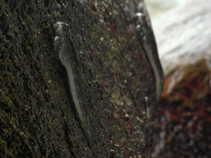| Family: |
Blenniidae (Combtooth blennies), subfamily: Salariinae |
| Max. size: |
6.4 cm SL (male/unsexed) |
| Environment: |
demersal; marine |
| Distribution: |
Eastern Indian Ocean: Christmas Island. |
| Diagnosis: |
Dorsal spines (total): 14-14; Dorsal soft rays (total): 19-21; Anal spines: 2-2; Anal soft rays: 24-25. Description: Dorsal fin XIV, 19-21; anal fin II, 24-25; pectoral rays 15; pelvic fin I,4; unbranched caudal rays; last anal ray bound to caudal fin by a membrane. Mouth, numerous movable jaw teeth; crenulated lips margin; lower lip with fleshy disc, cup-shaped; occipital crest absent. Body elongate; depth at anal fin origin 7.7-8.5 in SL. Overall brown; body with branching vertical dark markings; anal fin margin yellow (Ref. 90102). |
| Biology: |
Intertidal, found in rocky shorelines (Ref. 90102). Oviparous. Eggs are demersal and adhesive (Ref. 205), and are attached to the substrate via a filamentous, adhesive pad or pedestal (Ref. 94114). Larvae are planktonic, often found in shallow, coastal waters (Ref. 94114). |
| IUCN Red List Status: |
Data deficient (DD); Date assessed: 23 March 2009 Ref. (130435)
|
| Threat to humans: |
harmless |
Source and more info: www.fishbase.org. For personal, classroom, and other internal use only. Not for publication.

